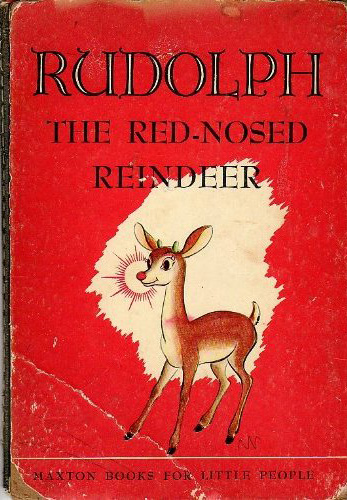The origin story of Rudolph the Red-Nosed Reindeer
How, exactly, did the most famous reindeer of all get so famous?


Many fictional holiday characters have origins rooted in actual history. Santa Claus, for example, is based loosely on a bishop named St. Nicholas known for giving anonymous gifts in a town in present-day Turkey. But what about Santa's trusty sidekick, Rudolph the Red-Nosed Reindeer? When did Santa start flying around the globe with a team of magical reindeer, and is there some epic Christmas Eve fog in the history books?
Rudolph the Red-Nosed Reindeer, a fairly new addition to Christmas lore, made his debut in 1939 as a promotional stunt for the Chicago-based department store Montgomery Ward. For years, the store had been buying and giving away Christmas-themed coloring books, but realized it could save a few bucks by making them in-house. So they asked Robert L. May, a 34-year-old copywriter, to create a holiday story specifically for their customers. May produced Rudolph, "the rollinckingest, rip-roaringest, riot-provokingest, Christmas give-away your town has ever seen!... A laugh and a thrill for every boy and girl in your town (and for their parents, too!)" May considered other names for his leading character, including Rodney, Rollo, Reginald, and Romeo (can you imagine Rodney the Red-Nosed Reindeer?), but eventually settled on Rudolph.

May's coloring book enjoyed instant success. The company gave away some 2 million copies in the first year. By comparison, only 430,000 copies of John Steinbeck's The Grapes of Wrath, a bestseller also published in 1939, were printed in its first year. The next year, Montgomery Ward began selling Rudolph-themed items and, later, May's brother-in-law wrote a song to accompany the book, which Gene Autry recorded in 1949. It remains the second-best selling Christmas song of all time. In the song, and later, the 1964 stop-animation TV special, Rudolph is an established, if bullied, member of Santa's reindeer family up at the North Pole before the fateful ride. In the book, however, Santa stumbles upon Rudolph for the first time when delivering gifts to his home one foggy Christmas eve — and drafts him as a navigation aid. "And you," Santa says in the book, "May yet save the day! Your wonderful forehead may yet pave the way!"
The Week
Escape your echo chamber. Get the facts behind the news, plus analysis from multiple perspectives.

Sign up for The Week's Free Newsletters
From our morning news briefing to a weekly Good News Newsletter, get the best of The Week delivered directly to your inbox.
From our morning news briefing to a weekly Good News Newsletter, get the best of The Week delivered directly to your inbox.
But when did Santa start hitching rides with reindeer? That piece of fiction can be traced back to 1823, when Clement C. Moore wrote the poem known today as The Night Before Christmas. Back then, it was called A Visit from St. Nicholas, and it told of Santa's "eight tiny rein-deer." (Fun fact: Donner and Blitzen, whose names translate to Thunder and Lightning, were originally called Dunder and Blixem.)
Today, Rudolph the Red-Nosed Reindeer remains a staple in American Christmas tradition. The 1964 production is the longest-running television special ever, and, with rapper DMX's recent rendition of the song, it's safe to say Rudolph will long be a permanent part of our pop culture lexicon.
A free daily email with the biggest news stories of the day – and the best features from TheWeek.com
Jessica Hullinger is a writer and former deputy editor of The Week Digital. Originally from the American Midwest, she completed a degree in journalism at Indiana University Bloomington before relocating to New York City, where she pursued a career in media. After joining The Week as an intern in 2010, she served as the title’s audience development manager, senior editor and deputy editor, as well as a regular guest on “The Week Unwrapped” podcast. Her writing has featured in other publications including Popular Science, Fast Company, Fortune, and Self magazine, and she loves covering science and climate-related issues.
-
 Political cartoons for December 6
Political cartoons for December 6Cartoons Saturday’s political cartoons include a pardon for Hernandez, word of the year, and more
-
 Pakistan: Trump’s ‘favourite field marshal’ takes charge
Pakistan: Trump’s ‘favourite field marshal’ takes chargeIn the Spotlight Asim Munir’s control over all three branches of Pakistan’s military gives him ‘sweeping powers’ – and almost unlimited freedom to use them
-
 Codeword: December 6, 2025
Codeword: December 6, 2025The daily codeword puzzle from The Week
